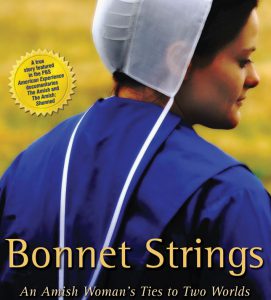
1960: Donald Draper (Jon Hamm) holds a high position in a renowned New York advertising agency, has an ex-model wife he calls “Betts” (January Jones), two kids, and a beautiful home. However, that is just the outside view of the protagonist’s life that is as multi-layered as the show itself. In the course of the decade-spanning seven seasons of Mad Men (2007 – 2015), the viewer gains revealing insights behind the so very appropriate facades of Don Draper and his fellow (m)ad men – and one (m)ad woman. Despite Don Draper being the show’s center, there are several plot lines being followed, for instance that of secretary Peggy Olson (Elisabeth Moss), who against all odds and conventions of the time aspires to a career that goes beyond wearing a tight dress, getting coffee, and operating a typewriter “simple enough for a woman to use.” Read more







 In the second half of the interview, we turn our attention to Saloma Miller Furlong’s Bonnet Strings: An Amish Woman’s Ties to Two World (2014), the succeeding installment to her ex-Amish memoir Why I Left the Amish (2011). Both books depict and reflect on the struggles to put the past behind and embrace an unknown future. In Bonnet Strings, however, before being able to seize the chance to find true happiness and love in the world beyond the Amish, Furlong feels compelled to return to her former community after coming face-to-face with a vanload of relatives and Amish community members in Vermont. Once in her old surroundings, she tries yet again to “wear Amish” and reconcile her rebellious nature with the Amish mindset.
In the second half of the interview, we turn our attention to Saloma Miller Furlong’s Bonnet Strings: An Amish Woman’s Ties to Two World (2014), the succeeding installment to her ex-Amish memoir Why I Left the Amish (2011). Both books depict and reflect on the struggles to put the past behind and embrace an unknown future. In Bonnet Strings, however, before being able to seize the chance to find true happiness and love in the world beyond the Amish, Furlong feels compelled to return to her former community after coming face-to-face with a vanload of relatives and Amish community members in Vermont. Once in her old surroundings, she tries yet again to “wear Amish” and reconcile her rebellious nature with the Amish mindset. Saloma Miller Furlong is author of the ex-Amish serial memoirs, Why I Left the Amish (2011) and Bonnet Strings: An Amish Woman’s Ties to Two Worlds (2014). She has also been featured on PBS American Experience documentaries,
Saloma Miller Furlong is author of the ex-Amish serial memoirs, Why I Left the Amish (2011) and Bonnet Strings: An Amish Woman’s Ties to Two Worlds (2014). She has also been featured on PBS American Experience documentaries, 
